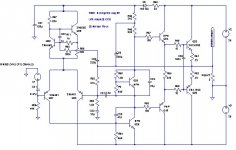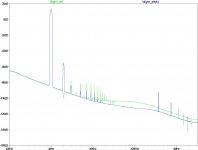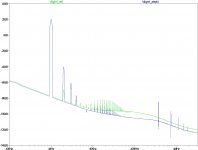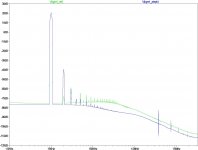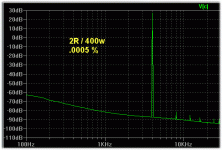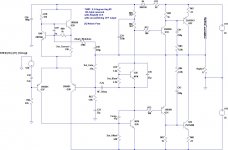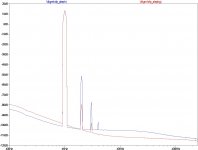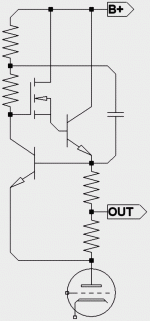Member
Joined 2009
Paid Member
So you want tube sound ?
Which kind ? - the SE triode kind but with lots of SS power. Well Nelson has shown the way already. Having spent the last week reading over the Zen papers I was deeply impressed with the simplicity, effectiveness and versatility of the Aleph Constant Current Source. Nelson used it optimize the THD and sound. There's actually a more informative understanding of this in Nelson's PLH paper but it isn't called the Aleph CCS there, it's called 'adjusting P2'.
One of the things I've been searching for is a knob on the front panel of my amplifier that reads 'turn clockwise for Jazz (tube) anti-clockwise for Rock (solid state)' and so exploring concepts like the Aleph is part of that search.
I took the Aleph CCS and put it into the TGM amplifier in the only spot that needs one. See attached schematic (the resolution of the image is bad, but you can see the TGM1 schematic and the Aleph CCS perched at the top of the LTP) .
Which kind ? - the SE triode kind but with lots of SS power. Well Nelson has shown the way already. Having spent the last week reading over the Zen papers I was deeply impressed with the simplicity, effectiveness and versatility of the Aleph Constant Current Source. Nelson used it optimize the THD and sound. There's actually a more informative understanding of this in Nelson's PLH paper but it isn't called the Aleph CCS there, it's called 'adjusting P2'.
One of the things I've been searching for is a knob on the front panel of my amplifier that reads 'turn clockwise for Jazz (tube) anti-clockwise for Rock (solid state)' and so exploring concepts like the Aleph is part of that search.
I took the Aleph CCS and put it into the TGM amplifier in the only spot that needs one. See attached schematic (the resolution of the image is bad, but you can see the TGM1 schematic and the Aleph CCS perched at the top of the LTP) .
Attachments
Member
Joined 2009
Paid Member
 Running simulations is easier than building so I took a look a the harmonics from the TGM-Aleph concept amplifier and compared them with the that of a similarly biassed TGM1 amplifier.
Running simulations is easier than building so I took a look a the harmonics from the TGM-Aleph concept amplifier and compared them with the that of a similarly biassed TGM1 amplifier.The first image (4kHz) is pretty revealing. The green trace shows the reference TGM amplifier (actually it might be a TGM2, but that's beside the point) with very little H2 since it's a symmetrical ClassAB output, then H3 and a number of higher order harmonics made up from a combination of output switching distortion, IM products and 'ghosts' from the simulation software. The blue trace is the new TGM-Aleph. There's a dominant H2 peak which can tuned in and out at will through a resistor value. Interestingly, the higher order harmonics are reduced in magnitude - this would be expected in the Zen amplifier but quite why I see it here I'm not sure, it may not be real.
I've looked at higher power levels and it scales very nicely indeed, H2 grows, followed by H3 and H4 with very little else afterwards. This can be seen in the 2nd image. Also 4kHz.
Taking it up to 15kHz the same behaviour is observed: third image.
Now, if we just combine this with the non-switching CFP output stage and perhaps there will be a new TGM amplifier design coming together...

Attachments
The same change in harmonics can be achieved by simply adding a resistor from the output to the "tail" in the ltp of a standard set up using a regular ring of two ccs. The lower the value the resistor the more H2 that will show up at the output. Did a few sim experiments with this but never actually built a test circuit.
By bigun - I've looked at higher power levels and it scales very nicely indeed, H2 grows, followed by H3 and H4 with very little else afterwards. This can be seen in the 2nd image. Also 4kHz.
wow , you are trying to ADD distortion ?? I have been trying lately to do the opposite. A factor that many overlook with simulations is the load. I found this out by paralleling another set of speakers on my monster amps to hear the difference. As far as the "tube sound" , try to create that before the amp , like a DAC/tube preamp combo or something similar.
Looking at those FFT's ,(I don't mean to be critical) , but they are horrible.Look at this one (attached) at 4khz /2R - 400 watts.
I will try that aleph CCS ( CCS fetish)..
OS
Attachments
Member
Joined 2009
Paid Member
wow , you are trying to ADD distortion ?? I have been trying lately to do the opposite. OS
Yes, that's correct, I am trying to give myself control over the distortion not to simply remove it all. I've been following your efforts - you're way too far ahead of me, my knowledge doesn't allow me to contribute...
But, currently what interests me are simple amps that I can try to understand and which through their particular distortion profile (and other properties) create a sound that is different in some way but which appeals to my ears (if only briefly !).
I still just want to learn and to play - sound wise the TGM2 (Hugh inspired clone) is all I need.
And if I limit myself to the same number of active devices and then reconfigure it with an Aleph CCS and non-switching CFP output I can get a clean distortion profile with 'dialled-in' H2/H3 if I want it.
For example, see attached showing two different levels of Aleph CCS modulation...which look cleaner than yours after the H2/3
Attachments
Last edited:
Adding many stages and followers you don't get a "simple amp" that you can try. There should be some very essential property of a single amp, that don't exist in a complex emulation of it, right?
And that property is, absence of some distortions you don't think about, instead of adding of some other distortions you are trying to add, simulating such a way.
You can add some side effects we are getting making simple amps, but you can't add an absence of what simple amps don't add.
Why do you think Zen amp has such a name?
And that property is, absence of some distortions you don't think about, instead of adding of some other distortions you are trying to add, simulating such a way.
You can add some side effects we are getting making simple amps, but you can't add an absence of what simple amps don't add.
Why do you think Zen amp has such a name?
Member
Joined 2009
Paid Member
Why do you think Zen amp has such a name?
Your intuition is rather sharp...
The Zen amp is indeed an inspiration. I am actually simulating the Zen amp in parallel to see if I can make something using parts I already have. There is 1986 defunct and grotty power supply on my desk that once I clean out the spiders and dust and remove the dead parts might end up as a housing for a low power Zen amp (this is why I've been reading Nelson's papers recently). Would you be interested if I were to post more on this ?
But the amp schematic I posted above is not that complex for a ClassAB amp is it. In fact, I think it's pretty economical with parts. It won't be a 'space heater' either.
Member
Joined 2009
Paid Member
by jerluwoo - The same change in harmonics can be achieved by simply adding a resistor from the output to the "tail" in the ltp of a standard set up using a regular ring of two ccs.
Absolutely , just adding one resistor from my CCS to tail I can double my H2.
By gordy - Ostripper, may I ask which amp provided that clean FFT result? Is it Diy-able or a commercial amp?
Yes you may
The switching distortion (H5/7) of the double EF with suckout cap is frequency and load dependent and might negate any H2 "maniplations" .
OS
Member
Joined 2009
Paid Member
Absolutely , just adding one resistor from my CCS to tail I can double my H2.
Yep, that's what I described and used on my TGM1. But, if you believe simulations, the Aleph modulated CCS is superior in terms of less higher order harmonics.
the Aleph modulated CCS is superior in terms of less higher order harmonics.
That is my point , vanishing H5/7. BUT , if your OP stage is reintroducing it , you are still at ground zero. I am "tinkering" now , to see if the aleph CCS in combo with my new "CCS powered type 3 triple" can come close to eliminating it altogether . just one more device can't hurt.
BTW , on your TGM/aleph , what are your tail currents??
OS
I don't mind the Aleph's gate bootstrap cap, its like a freebie CCS...
But I don't care for the coupling cap. Though Nelson sais his 220uF
is less a problem than non-linear gate capacitance, gate worries me
too...
Anyways, here I direct couple an Aleph through the emitter.
And the split sense resistor, compared to the fixed VBE drop
of one emitter computes all the active current sink magic...
The downside to this, is now your plate is driving the gate of the
mosfet (as if the emitter wasn't there). So you want this gate to
be small and easy to drive. I find a Darlington arrangement drives
friendlier than one huge mosfet.
But I don't care for the coupling cap. Though Nelson sais his 220uF
is less a problem than non-linear gate capacitance, gate worries me
too...
Anyways, here I direct couple an Aleph through the emitter.
And the split sense resistor, compared to the fixed VBE drop
of one emitter computes all the active current sink magic...
The downside to this, is now your plate is driving the gate of the
mosfet (as if the emitter wasn't there). So you want this gate to
be small and easy to drive. I find a Darlington arrangement drives
friendlier than one huge mosfet.
Attachments
Above post was intended for your other similarly themed thread.
http://www.diyaudio.com/forums/showthread.php?t=150430
I guess I had them both open at once, and got mixed up...
http://www.diyaudio.com/forums/showthread.php?t=150430
I guess I had them both open at once, and got mixed up...
Member
Joined 2009
Paid Member
That is my point , vanishing H5/7. BUT , if your OP stage is reintroducing it , you are still at ground zero. I am "tinkering" now , to see if the aleph CCS in combo with my new "CCS powered type 3 triple" can come close to eliminating it altogether . just one more device can't hurt.
BTW , on your TGM/aleph , what are your tail currents??
OS
It would be interesting to combine it with the Triple OS. There's always the danger that my sims are not 'good' in some way I've overlooked so it will be interesting to hear what you discover.
My current thinking now is that the additional benefits of the non-switching CFP output look HUGE so I am only continuing simulations on the combination of TGM-Aleph-(non-switching)CFP.
The tail currents in the sim are running at around 2.7mA, that's means a good solid current down each leg. I haven't looked at the impact of different current levels but the Aleph CCS might not behave so advantageously at low currents.
Kenpeter - thanks for the response, I know it was aimed at my thread on a Hybrid amp in the tubes forum but I think this is the right thread to talk about the Aleph CCS - the other thread is really to focus on a Tube-MOSFET CFP hybrid and the Aleph CCS is simply a carry-over from my use of the Zen amp as a starting point. I fear I have too much going on !
Last edited:
- Status
- This old topic is closed. If you want to reopen this topic, contact a moderator using the "Report Post" button.
- Home
- Amplifiers
- Solid State
- Tube Sound ? - meet the Aleph CCS
